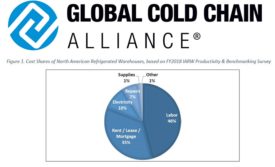Home » Keywords: » warehouse trends
Items Tagged with 'warehouse trends'
ARTICLES
The Maryland facility--which serves all 163 Giant Food stores--now has 106 dock doors, a 20% increase.
Read More
GCCA Releases Q1 Cold Chain Index for Cost of Operating Refrigerated Warehouses
Labor accounted for the largest share of expenses, followed by property rent/lease/mortgage costs.
May 29, 2020
Report shows cold storage gaining favor with investors for traditional warehouses
However, challenges stemming from the specialized nature of the sector will continue to restrain additional growth in transaction volume.
December 11, 2019
Things to consider when buying warehouse space
Finding sufficient climate-controlled storage space poses one of the biggest challenges in the refrigerated sector.
November 19, 2019
Study unveils technological changes in logistics industry
The study projects that the industry likely won’t experience dramatic job loss over the next decade, though many workers may see the content and quality of their jobs shift as technologies are adopted for particular tasks.
October 29, 2019
Study: Demand for smaller facilities is on the rise
Construction completions of light industrial warehouses smaller than 120,000 square feet have averaged 1% of the category’s overall stock since 1990.
October 10, 2019
Report reveals investors can find industrial, logistics real estate opportunities in markets outside major gateways
These markets registered demand for industrial and logistics real estate that outpaced their supply by a collective 89 million square feet since 2013.
August 29, 2019
Study: 6 in 10 operations decision makers plan warehouse automation to augment labor by 2024
Both automation and worker augmentation solutions will be a key focus for decision makers’ plans during the next five years.
June 20, 2019
Report: Warehouse sector's construction rate supported by e-commerce demand
In-progress warehouse construction in the United States totaled 255 million square feet at the end of this year’s first quarter.
June 20, 2019
Elevate your expertise in refrigerated and frozen foods with unparalleled insights and connections.
Get the latest industry updates tailored your way.
JOIN TODAY!Copyright ©2024. All Rights Reserved BNP Media.
Design, CMS, Hosting & Web Development :: ePublishing





